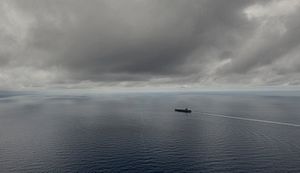In the National Interest, Thomas Mitchell proposes a new Washington Naval Treaty to arrest the arms race in and around the South China Sea. Mitchell argues that a carefully calibrated treaty could reduce tensions across the region by eliminating security dilemma dynamics (the security of one state breeds vulnerability in others) and by guaranteeing a sphere of influence for each major partner. Although I believe that the Washington Naval Treaty system was more successful than is commonly understood, I have serious reservations about any contemporary conference.
It’s worth re-examining what the Washington Naval Treaty did, and what it was intended to accomplish. The Washington Naval Treaty of 1922 defused a brewing arms race between the United States, Japan, and the United Kingdom. Each country had begun to lay down a new generation of battleships, a competition that stood a good chance of bankrupting London and Tokyo. The United States had the economic wherewithal to run the race, but little interest in doing so. All of the participants agreed on the basic unit of national power: The dreadnought battleship. The treaty provided for the decommissioning of many ships, as well as strict limits on new construction and on ship characteristics.
We cannot understate the importance of this basic level of agreement between the major powers. Acknowledgement of the central role of the battleship in maritime power made for an easy, understandable, actionable metric for cooperation. That all three powers turned out to be wrong about the battleship (the submarine and aircraft carrier would play far more important roles in the Pacific War than the battleship, and the treaty touched on them only in passing), was not relevant to the outcome of negotiations. The arms negotiators did not need to endure complex negotiations over how many smaller ships might constitute a “battleship equivalent,” or about how battleships might mean different things to different countries under different circumstances. To be sure, the Treaty did acknowledge the tyranny of distance by precluding the United States from improving its Far Eastern bases, but this understanding was built on readily available assumptions about the effectiveness of naval forces at range.
It’s also important to note that the adherents to the Five Power Treaty (and especially the top three) all saw themselves as victors in the recent World War. None of the powers sought, at least initially, to expand their Pacific holdings, and all were relatively satisfied with the post-war status quo. The Treaty was about resolving a security dilemma between friendly powers, rather than resolving disputes between adversaries. To be sure, the United States and Japan viewed each other as potential adversaries in the long run, and the British and the Americans had to endure a brief war scare before all was said and done, but the major revisionist powers (Germany, the Soviet Union, China) remained outside of the system, or too weak to participate in it.
Can the major powers of East Asia agree on a political settlement that would resolve the major issues of dispute, and would a restriction on the development of certain arms play a role in this settlement? At the moment, few of the conditions that enabled the Washington Treaty hold. In particular, a four sided arms limitation negotiation between Washington, Beijing, and Tokyo, and Delhi would need to deal with complex, thorny questions about how different kinds of systems interacted with one another. What combination of cruise missiles, ballistic missiles, submarines, and reconnaissance aircraft would equal a U.S. Navy supercarrier? A big amphib? Japan’s Izumo-class light carriers? The major players do not share a common metric of aerospace/maritime power, and thus there is no obvious space for agreement on relative military capabilities.
Perhaps more importantly, the national strategic objectives of the four states cannot easily be resolved by resort to “sphere of influence” politics. The United States and Japan view a Chinese sphere of interest in the SCS as directly inimical to their interests; the Chinese have a similar view of India in the Indian Ocean.
In the end, the Washington Naval Treaty system was undone not by technological change, but by a shift in national interest. All three of the major powers held to the centrality of the battleship into the late 1930s, even as Japan and the United States shifted greater attention to naval aviation. Japan’s rejection of the international status quo made the survival of the Treaty system impossible. In short, our current situation bears more resemblance to the end of the Treaty, than to its beginning. This suggests very little hope for arms limitation in the broader Asia-Pacific.

































